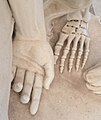El petó de la mort
El petó de la mort (catal.), Also El beso de la muerte (Spanish; German. The kiss of death ), is the most famous marble sculpture on the Cementiri del Poblenou, a cemetery in the El Poblenou district of the Catalan capital Barcelona . It was created in 1930 on behalf of the family of Josep Llaudet i Soler, an important family of manufacturers, for a son who died young in the workshop of the marble cutter and sculptor Jaume Barba.
Design and execution
It is not known who made the final draft of the sculpture, which was created in 1930 in the studio of the Catalan marble cutter and sculptor Jaume Barba - he was around 70 years old at the time - under his name: the signature “J. Barba ”can be found at the front on one side of the octagonal base.
Joan Fontbernat Paituví, Barba’s son-in-law and the most skilled sculptor in his workshop, was inspired by the illustration of a relief by Lorenzo Maroni from Italy. Maroni had created the relief for the tombstone of the family of Ercole Mentasti (1843-1909) on the Cimetero Monumentale in Milan around 1910. The free-standing Spanish sculpture looks very similar to the Italian relief. It is believed that it was Fontbernat who carried out the three-dimensional elaboration of the relief to create an expressive sculpture. The realism of the ribs is attributed to the artistry of Artemi Barba.
presentation
The sculpture is extremely realistic in most areas. It shows a kneeling, well-formed young man with his head turned to the right, eyes closed and mouth slightly open. A cloth covers his loins, his arms hang limply, the hands are open, the backs of the hands or fingers rest on the floor.
Laterally from left to prevent the death , personalized as Angel of Death - a skeleton with wings - over him, holding him under the right shoulder and the left arm and kisses him on the temple . Death also wears a cloth that partially covers him and artistically lets the bones protrude (see for example the folds around the thigh bone in the view from behind shown below).
Based on the portrayal of the man, one can recognize resignation, relaxed acceptance or even an erotic moment - the portrayal “is both romantic and terrible at the same time”. Death does not come as a reaper with a scythe , it comes as an "ally" and with a kiss it redeems the man who thereby arrives in eternal life.
Grave site and inscription
The sculpture stands on the grave of the Catalan textile manufacturer Josep Llaudet i Soler (1879–1955), the grave slab bears his name "Llaudet Soler" without any further information. His son, who died at a young age, was buried in the grave as early as 1930. For the design of the sculpture, the family provided a quatrain by the Catalan poet Jacinto Verdaguer (1845–1902). This text is engraved on a natural stone base under the sculpture.
|
|
German translation |
reception
The sculpture is often mentioned in city guides of Barcelona as clearly the most famous of the Cementiri del Poblenou. The path suggested for visitors at the cemetery entrance , which leads past a total of 30 important buildings and sculptures, ends at El petó de la mort .
- Andreu Martín and Alfonso López used a graphic version of El petó de la mort for the cover of their comic book Máxima discreción (2011) .
- The illustrator Carlos Ruiz Gallardo was also inspired by the positioning of the figures in the sculpture when illustrating stories by Edgar Allan Poe .
- The frequently quoted claim that Ingmar Bergman was inspired by the sculpture for the film The Seventh Seal can not be substantiated - for example with the book Ingmar Bergman: A Reference Guide .
Individual evidence and declarations
- ↑ a b c d Carmen Diez Carrera: El Beso de la Muerte , Rutas con Historia; accessed on August 10, 2017.
- ↑ Joan Fontbernat Paituví was the husband of Dolores Barba, the daughter of Jaume Barba.
- ↑ Albert Domènech: Piscolabis Librorum: El bes de la Mort, el vers petrificat de Mossèn Cinto , November 1, 2008; accessed on August 23, 2017.
- ↑ Exceptions are, for example, the man's unnatural costal arch and the wing joint of the death sine in the middle of the shoulder blade.
- ↑ Raimon Arola: ARSGRAVIS La muerte del beso (Span.). There also further explanations on the meaning of the kiss in connection with death; accessed on August 14, 2017.
- ↑ Universidad Complutense Madrid: El Petó de la Mort / The Kiss of Death / El Beso de la Muerte ; accessed on August 24, 2017.
- ^ Año Cero: Hermetismo de ultratumba ; accessed on August 24, 2017.
- ^ Translation by J. Cuber (according to information from G. Küppers, Gelsenkirchen, August 14, 2017).
- ↑ Mireia Mullor: El cementerio de Poblenou, un museo al aire libre , El Mundo , December 22, 2015; q Retrieved August 14, 2017.
- ↑ Lonely Planet: Barcelone City Guide - 10ed . Place des éditeurs, March 16, 2017, ISBN 978-2-8161-6581-4 , p. 109.
- ↑ Lonely Planet: Lonely Planet Best of Barcelona: Top sights, authentic experiences . Lonely Planet, November 21, 2016, ISBN 978-1-78657-834-1 , p. 186.
- ↑ Guia del Comic: Andreu Martín and Alfonso López: Máxima discreción (2011) ; accessed on August 15, 2017.
- ↑ Ravings of Love and Death: Edgar Allan Poe . Play Attitude, 10 September 2013, ISBN 978-84-15149-44-6 , p. 152.
- ↑ Birgitta Steene: Ingmar Bergman: A Reference Guide . Amsterdam University Press, 2005, ISBN 978-90-5356-406-6 .
Coordinates: 41 ° N , 2 ° E












